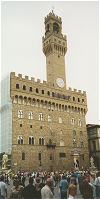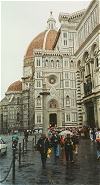City of arts: Florence
Florence (Firenze) - the capital of the Italian province of Tuscany - lies at the Arno River, halfway the northern industrial centres and Rome. The city houses some 400,000 inhabitants, suburbia included, 600,000.
History in a nutshell
 Founded in BC 59 as a colony for retired Roman military, Florence quickly expands into a formidable trading town. Invasions during periods of mass migration disrupt its growth, but peace and prosperity return when Charlemagne draws the area into his Frankish empire in the 9th century. The city's bigwigs become the big bosses of the Church.
Founded in BC 59 as a colony for retired Roman military, Florence quickly expands into a formidable trading town. Invasions during periods of mass migration disrupt its growth, but peace and prosperity return when Charlemagne draws the area into his Frankish empire in the 9th century. The city's bigwigs become the big bosses of the Church.
 With the city's economic development the influence of its craftsmen and traders increases. In 1183 Florence gets its own government. As a result the city's power extends to the surrounding area until one day Florence becomes an independent city state.
With the city's economic development the influence of its craftsmen and traders increases. In 1183 Florence gets its own government. As a result the city's power extends to the surrounding area until one day Florence becomes an independent city state.
The 13th century marks the beginning of the desire to flaunt prosperity, hence the construction of the dome and the Palazzo Vecchio. Churches too are richly furnished.
After a turbulent period, the De' Medici family gradually begins to usurp power at the end of the 14th century. The family owe their fortune to successful national and international trade and to banking, being the private banker to the Pope. This was a time when the interest in the classics grew. Lorenzo il Magnifico de' Medici took the Florentine renaissance to the summit, being responsible for consignments to such artists as Botticelli, Michelangelo and Da Vinci.
Not everyone felt comfortable with all the pomp and circumstance and its whiff of decay. On instigation of a Puritan monk, the De' Medici family were banished from the town at the end of the 15th century. In 1512 they were allowed back, to reign until the 18th century. Again the arts flourished in Florence, although by now Rome was more important. In 1597 Florence saw the premiere of the first opera ever.
In 1860 the city relinquished its independence to join a new, united Italy for which it was the capital for several years.
Art & culture
Well - where to begin? The French author Stendhal suffered an anxiety attack on visiting Florence, completely overwhelmed as he was by the abundance of things to see. This type of anxiety has been known as Stendhal Syndrome ever since. Until this day several people a year are admitted to hospital with the same symptoms. Be warned!
- The Cathedral, with its famous dome by Brunelleschi. The cathedral is the work of several architects, among whom Giotto, who also drew the separate campanile (bell tower). The interior is modest; it contains an Ascension by Luca della Robbia. Many of the works of art which were originally inside or on the Dome and bell tower are now kept in the Museo del Duomo: e.g. a pietà by Michelangelo.
- Galleria dell' Accademia, has many sculptures and as showpiece the David by Michelangelo. A replica stands at the entrance to the Palazzo Vecchio.
- Brancacci Chapel in the Santa Maria del Carmine has a series of famous pre-renaissance artists, such as Masaccio and Masolino, rounded off by Filippino Lippi.
- Museo di San Marco is a former monastery, which has cells with frescoes fresco's by Fra Angelico.
- Palazzo Pitti, a large palace on the other bank of the Arno. Once a pied-a-terre for Cosimo I de' Medici, now a location harbouring amongst other things the museum Galleria Palatina. The collection contains the likes of Ezekiel's vision by Raphael.
- Galleria degli Uffizi, former offices of the grand duke and transformed into a museum. The Uffizi is one of the world's oldest and richest museums with such fine works as:
- An impressive collection of paintings of the Adoration of the Magi, by masters like Botticelli, Albrecht Dürer, Ghirlandaio, Andrea Mantegna, Leonardo da Vinci
- Botticelli: Primavera, Birth of Venus, The discovery of the murder of Holophernes
- Caravaggio: The Sacrifice of Isaac
- Hugo van der Goes: The Adoration of the Shepherds
- Leonardo da Vinci: Annunciation
- Simone Martini: Annunciation
- Rogier van der Weyden: Entombment
- Andrea del Verrocchio with a little help from Leonardo da Vinci: The baptism of Christ
- Michelangelo: The Holy Family
- Santa Croce: a sizable church with monuments and commemorative stones for Italian giants, including the artist Michelangelo, the natural scientist Galileo Galilee, the political scientist Machiavelli and the poet Dante Alighieri. The beautifully furnished church contains works of art by, among others, Giotto and Donatello.
So much for our small selection of Florence's art treasures. In the vicinity there is even more art and culture to enjoy. Just outside of Florence lies the town of Fiesole - up in the hills and therefore at one time more powerful than Florence. At less than an hour's drive you'll discover beautiful Siena where the Maesta by Duccio is kept. All of Tuscany, in short, is well worth a visit.